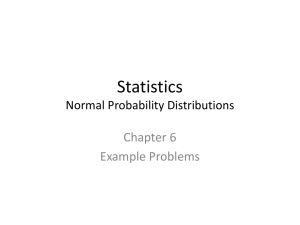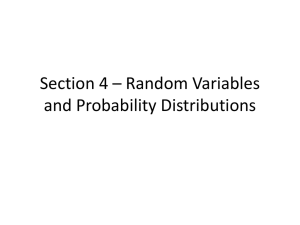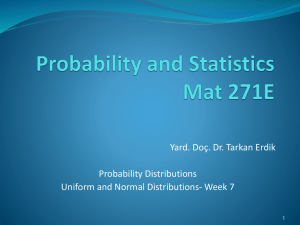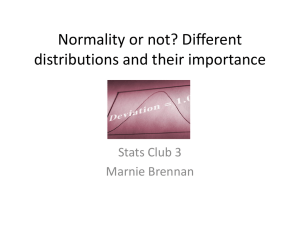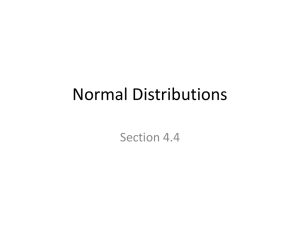2.2
advertisement
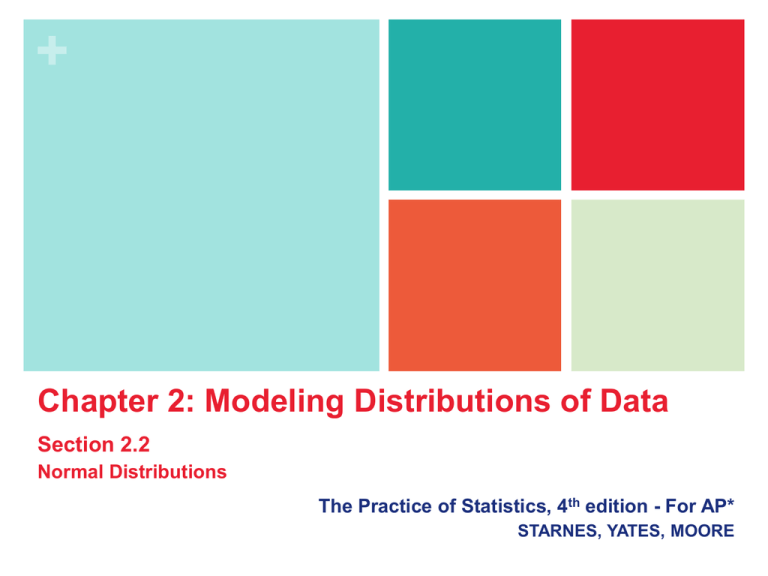
+ Chapter 2: Modeling Distributions of Data Section 2.2 Normal Distributions The Practice of Statistics, 4th edition - For AP* STARNES, YATES, MOORE + Chapter 2 Modeling Distributions of Data 2.1 Describing Location in a Distribution 2.2 Normal Distributions + Section 2.2 Normal Distributions Learning Objectives After this section, you should be able to… DESCRIBE and APPLY the 68-95-99.7 Rule DESCRIBE the standard Normal Distribution PERFORM Normal distribution calculations ASSESS Normality One particularly important class of density curves are the Normal curves, which describe Normal distributions. All Normal curves are symmetric, single-peaked, and bellshaped A Specific Normal curve is described by giving its mean µ and standard deviation σ. Two Normal curves, showing the mean µ and standard deviation σ. Normal Distributions Distributions + Normal Definition: A Normal distribution is described by a Normal density curve. Any particular Normal distribution is completely specified by two numbers: its mean µ and standard deviation σ. •The mean of a Normal distribution is the center of the symmetric Normal curve. •The standard deviation is the distance from the center to the change-of-curvature points on either side. + Distributions Normal Distributions Normal •We abbreviate the Normal distribution with mean µ and standard deviation σ as N(µ,σ). Normal distributions are good descriptions for some distributions of real data. Normal distributions are good approximations of the results of many kinds of chance outcomes. Many statistical inference procedures are based on Normal distributions. The 68-95-99.7 Rule Definition: The 68-95-99.7 Rule (“The Empirical Rule”) In the Normal distribution with mean µ and standard deviation σ: •Approximately 68% of the observations fall within σ of µ. •Approximately 95% of the observations fall within 2σ of µ. •Approximately 99.7% of the observations fall within 3σ of µ. Normal Distributions Although there are many Normal curves, they all have properties in common. + a) Sketch the Normal density curve for this distribution. b) What percent of ITBS vocabulary scores are less than 3.74? c) What percent of the scores are between 5.29 and 9.94? Normal Distributions The distribution of Iowa Test of Basic Skills (ITBS) vocabulary scores for 7th grade students in Gary, Indiana, is close to Normal. Suppose the distribution is N(6.84, 1.55). + Example, p. 113 All Normal distributions are the same if we measure in units of size σ from the mean µ as center. Definition: The standard Normal distribution is the Normal distribution with mean 0 and standard deviation 1. If a variable x has any Normal distribution N(µ,σ) with mean µ and standard deviation σ, then the standardized variable z x - has the standard Normal distribution, N(0,1). Normal Distributions Standard Normal Distribution + The + Standard Normal Table Because all Normal distributions are the same when we standardize, we can find areas under any Normal curve from a single table. Definition: The Standard Normal Table Table A is a table of areas under the standard Normal curve. The table entry for each value z is the area under the curve to the left of z. Suppose we want to find the proportion of observations from the standard Normal distribution that are less than 0.81. We can use Table A: Z .00 .01 .02 0.7 .7580 .7611 .7642 0.8 .7881 .7910 .7939 0.9 .8159 .8186 .8212 P(z < 0.81) = .7910 Normal Distributions The + Example, p. 117 Finding Areas Under the Standard Normal Curve Normal Distributions Find the proportion of observations from the standard Normal distribution that are between -1.25 and 0.81. Can you find the same proportion using a different approach? 1 - (0.1056+0.2090) = 1 – 0.3146 = 0.6854 How to Solve Problems Involving Normal Distributions State: Express the problem in terms of the observed variable x. Plan: Draw a picture of the distribution and shade the area of interest under the curve. Do: Perform calculations. •Standardize x to restate the problem in terms of a standard Normal variable z. •Use Table A and the fact that the total area under the curve is 1 to find the required area under the standard Normal curve. Conclude: Write your conclusion in the context of the problem. + Distribution Calculations Normal Distributions Normal + Distribution Calculations When Tiger Woods hits his driver, the distance the ball travels can be described by N(304, 8). What percent of Tiger’s drives travel between 305 and 325 yards? Whenx = 305, z = 305- 304 0.13 8 Whenx = 325, z = 325- 304 2.63 8 Normal Distributions Normal Using Table A, we can find the area to the left of z=2.63 and the area to the left of z=0.13. 0.9957 – 0.5517 = 0.4440. About 44% of Tiger’s drives travel between 305 and 325 yards. The Normal distributions provide good models for some distributions of real data. Many statistical inference procedures are based on the assumption that the population is approximately Normally distributed. Consequently, we need a strategy for assessing Normality. Plot the data. •Make a dotplot, stemplot, or histogram and see if the graph is approximately symmetric and bell-shaped. Check whether the data follow the 68-95-99.7 rule. •Count how many observations fall within one, two, and three standard deviations of the mean and check to see if these percents are close to the 68%, 95%, and 99.7% targets for a Normal distribution. + Normality Normal Distributions Assessing Most software packages can construct Normal probability plots. These plots are constructed by plotting each observation in a data set against its corresponding percentile’s z-score. Interpreting Normal Probability Plots If the points on a Normal probability plot lie close to a straight line, the plot indicates that the data are Normal. Systematic deviations from a straight line indicate a non-Normal distribution. Outliers appear as points that are far away from the overall pattern of the plot. Normal Distributions Probability Plots + Normal + Section 2.2 Normal Distributions Summary In this section, we learned that… The Normal Distributions are described by a special family of bellshaped, symmetric density curves called Normal curves. The mean µ and standard deviation σ completely specify a Normal distribution N(µ,σ). The mean is the center of the curve, and σ is the distance from µ to the change-of-curvature points on either side. All Normal distributions obey the 68-95-99.7 Rule, which describes what percent of observations lie within one, two, and three standard deviations of the mean. + Section 2.2 Normal Distributions Summary In this section, we learned that… All Normal distributions are the same when measurements are standardized. The standard Normal distribution has mean µ=0 and standard deviation σ=1. Table A gives percentiles for the standard Normal curve. By standardizing, we can use Table A to determine the percentile for a given z-score or the z-score corresponding to a given percentile in any Normal distribution. To assess Normality for a given set of data, we first observe its shape. We then check how well the data fits the 68-95-99.7 rule. We can also construct and interpret a Normal probability plot. + Looking Ahead… In the next Chapter… We’ll learn how to describe relationships between two quantitative variables We’ll study Scatterplots and correlation Least-squares regression




